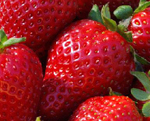Best June recipes from Country Life
A delicious recipe for strawberry jam and a fabulous pea and mint soup are particularly recommended for June


The benefits of eating seasonal produce are immeasurable. Better for the environment, better for health and better for the British farming economy, and often, the more simple the method of cooking and serving, the more delicious the feast.
Asparagus, for example, picked, washed, steamed for a couple of minutes over boiling water and dipped into melted butter and salt is a June seasonal sensation, all the more delicious for its limited availability. A similar method can be applied to the globe artichoke, steam and dip the leaves into salty melted butter - being careful to avoid the chock surrounding the delicately flavoured heart.
A bowl of ripe strawberries and early raspberries sprinkled with a dash of rose water and caster sugar and left to stand is the most delicious pudding with a spoonful of yogurt or double cream.
Now is the time to enjoy the fruits of the field at their simplest and best, below are a couple of favourite recipes and a list of other June goodies.
* For more stories like this every week subscribe and save
Strawberry jam recipe Makes 3-6 jars
Ingredients 1kg /2lb 3oz strawberries 1kg/2lb 3oz granulated sugar or caster sugar ½ lemon, juice only
Sign up for the Country Life Newsletter
Exquisite houses, the beauty of Nature, and how to get the most from your life, straight to your inbox.
Method Hull and halve the strawberries, remove soft spots and discard any overripe or bruised berries.
Leave the strawberries to stand in a large bowl mixed with 500g/18oz of the sugar in the fridge overnight.
Place a saucer into the freezer to chill - this will be required to test the setting point of the jam.
Sterilise the jam jars, wash in soapy water and rinse in clean warm water. Allow them to drip-dry, upside down, on a rack in the oven set to 140C/275F/Gas 1. Leave them to dry while you make the jam.
Pour the strawberries, their juice and any residual sugary juices into a very large pan or preserving pan, remembering that the mixture will rise as it boils, and add the remaining 500g/18oz sugar and the lemon juice.
Stir over a gentle heat until the sugar has completely dissolved.
Bring the strawberries to the boil then boil hard until the jam reaches setting point. Check the setting point every ten minutes, although it may take up to half an hour to reach setting point.
To test the setting point, remove the pan from the heat. Take your saucer from the freezer and place a drop of jam onto the cold plate. After a few seconds push the jam with your finger, if the jam surface wrinkles then it has reached setting point and is ready. If it slides about as a liquid, then it hasn't reached setting point and should be returned to the heat and boiled for a few more minutes before testing again.
When setting point has been reached remove from the heat and skim off any scum on the surface of the jam with a large spoon.
Let the jam cool and thicken in the pan for ten minutes, so that the strawberries don't all sink to the bottom in the jam jars.
Carefully remove the sterilised jars from the oven with oven gloves.
Stir the jam, then ladle it into the sterilised jars.
Cover the top surface of the jam in each jar with waxed paper discs that have been cut to size - they should cover the entire surface of the jam. Press the wax disc down to create a complete seal.
Cover with a lid while still hot, label and store in a cool, dark cupboard for up to a year.
Pea and mint soup recipe
Serves 4 as a first course
Ingredients 1 tbsp olive oil 2 large shallots, chopped 1 stem celery, finely chopped 600ml vegetable or chicken stock 400g fresh peas (1kg in pods) Salt and freshly ground pepper 10g mint, leaves only, roughly chopped Crème fraîche, thick double cream or low-fat yogurt, to serve
Method Season and sweat the shallots and celery over a very gentle heat until completely soft but un-coloured.
Add the stock and bring to a gentle simmer, then add the peas and simmer for a few minutes until the peas are soft. Remove from the heat, add the chopped mint, and purée. Taste and adjust the seasoning. Serve warm or chilled, garnished with a swirl of cream or yogurt, a sprig of mint, lots of black pepper and a slice of melba toast.
Also in season in June
Apricots, Artichoke, Asparagus, Aubergine, Basil, Blueberries, Broad Beans, Broccoli, Carrots, Cherries, Cod, Crab, Dover Sole, Elderflower, Fennel, Gooseberries, Grey Mullet, Haddock, Halibut, Herring, Jersey Royal new potatoes, John Dory, Lamb, Lemon sole, Lettuces and salad leaves, Lobster, Mackerel, Mangetout, Melons, Mint, New Potatoes, Plaice, Radishes, Raspberries, Rhubarb, Rocket, Rosemary, Runner beans, Salmon, Samphire Sardines, Sea Bass, Sea Trout, Shrimp, Sorrel, Spinach, Spring Onions, Tarragon, Tayberries, Tomatoes, Turnips, Watercress, Whitebait, Wood pigeon.
To comment on this article, use the comment box below, or email us at clonews@ipcmedia.com. Read more about the countryside.
Country Life is unlike any other magazine: the only glossy weekly on the newsstand and the only magazine that has been guest-edited by HRH The King not once, but twice. It is a celebration of modern rural life and all its diverse joys and pleasures — that was first published in Queen Victoria's Diamond Jubilee year. Our eclectic mixture of witty and informative content — from the most up-to-date property news and commentary and a coveted glimpse inside some of the UK's best houses and gardens, to gardening, the arts and interior design, written by experts in their field — still cannot be found in print or online, anywhere else.
-
 380 acres and 90 bedrooms on the £25m private island being sold by one of Britain's top music producers
380 acres and 90 bedrooms on the £25m private island being sold by one of Britain's top music producersStormzy, Rihanna and the Rolling Stones are just a part of the story at Osea Island, a dot on the map in the seas off Essex.
By Lotte Brundle
-
 'A delicious chance to step back in time and bask in the best of Britain': An insider's guide to The Season
'A delicious chance to step back in time and bask in the best of Britain': An insider's guide to The SeasonHere's how to navigate this summer's top events in style, from those who know best.
By Madeleine Silver